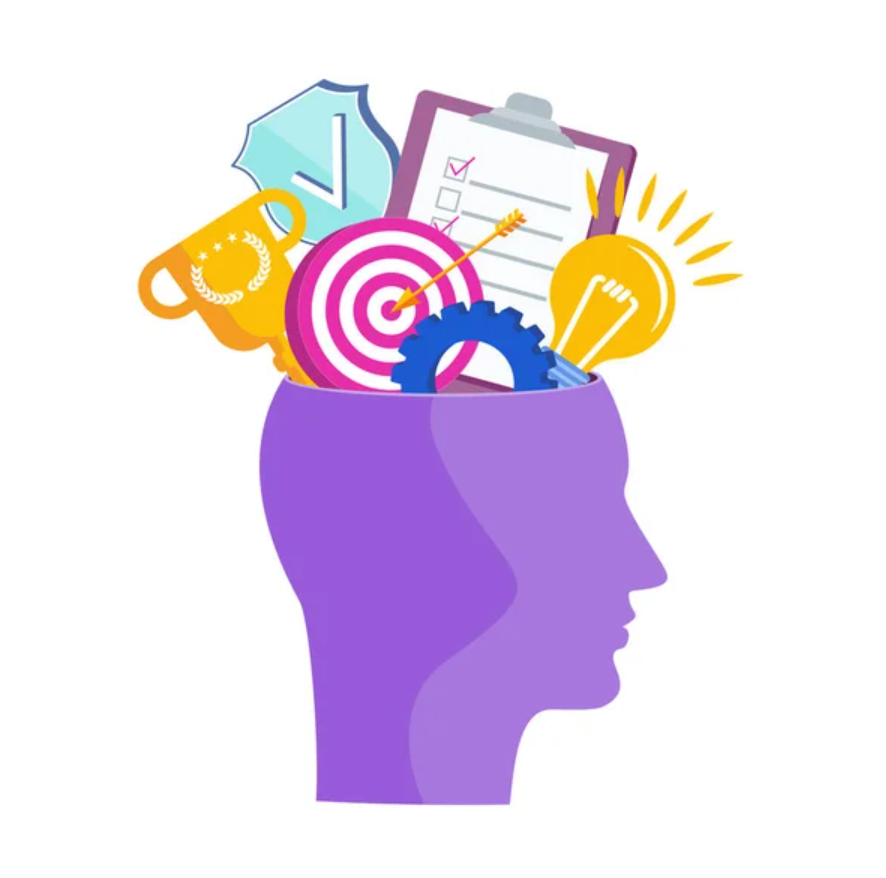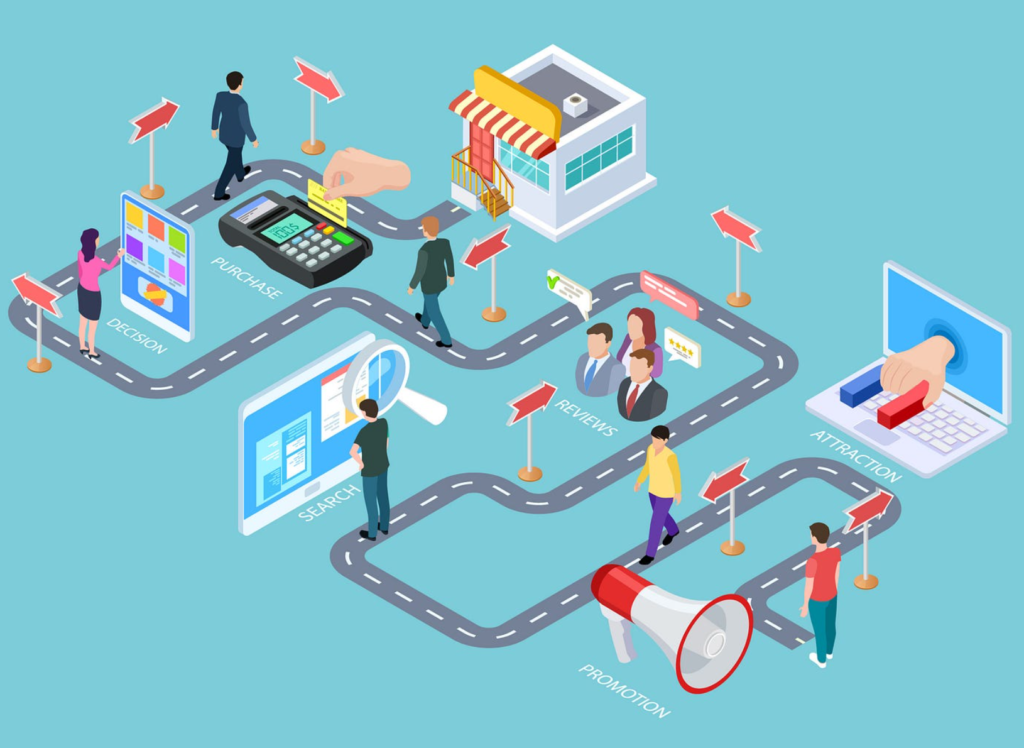The importance of visualising your customer journey map cannot be overstated. In a world overwhelmed by data, visual elements such as charts, diagrams, and colour coding provide clarity and insight that text alone cannot achieve.
The Importance of Customer-Centricity
Becoming customer-centric is no longer an option; it’s a necessity for businesses that want to thrive. Customer-centricity means placing the customer at the heart of every business decision. Understanding the significance of this approach is critical for professionals, as it directly influences conversion optimisation.
In the context of conversion optimisation, customer-centricity means that every strategy, decision, and action revolves around the customer’s needs, preferences, and expectations.
When a business truly understands and respects the importance of its customers, it is better equipped to tailor its conversion optimisation efforts to precisely meet those customers’ requirements. This isn’t just a superficial modification; it’s a holistic transformation that affects every aspect of a company’s journey toward higher conversion rates.
The customer’s journey becomes the focal point, with touchpoints carefully crafted to resonate with the customer’s emotions and desires. By immersing itself in the customer’s perspective, a business can create a customer-centric narrative that guides customers seamlessly through the conversion funnel. The result is not just higher conversion rates, but also customer loyalty, advocacy, and long-term success.
Key Stages in the Customer Journey
A customer’s journey is not linear; it involves various stages, from awareness to post-purchase interactions. Each stage holds unique opportunities and challenges. By comprehending these stages and their intricacies, you can tailor your strategies to enhance conversions at every touchpoint.

- Awareness Stage:
This is where the journey begins. To analyse the awareness stage, you need to identify how customers are discovering your business. This can be through organic search, paid advertising, or referrals. Analyse the source of traffic, demographics, and entry points to understand where your audience is coming from. Understanding the entry points into your online domain is crucial. Are customers predominantly landing on your homepage, product pages, or through specific blog posts? Analysing the entry points provides valuable insights into the content and touchpoints that are attracting potential customers.
- Consideration Stage:
In the consideration stage, customers actively explore your offerings and compare them to alternatives. Analyse the actions customers take during the consideration stage. This includes tracking page views, content consumption, and interactions with your sales or support teams. It’s crucial to identify what information customers seek and what influences their decisions.
A visual representation can help you understand the content and touchpoints that impact their decision-making process.
- Decision Stage:
This is where customers make the final decision to purchase your product or service. Analyse the decision stage by tracking conversion rates, cart abandonment rates, and the use of discount codes or incentives. Understand what factors influence the decision-making process, such as pricing, trust signals, or a smooth checkout process.
- Post-Purchase Stage:
The journey doesn’t end with a purchase. The post-purchase stage involves the customer’s experience after buying your product or service. Analyse the post-purchase stage by tracking customer satisfaction, customer support interactions, and product usage. Identify pain points, areas of delight, and opportunities for upselling or cross-selling.
Create a visual representation that outlines the customer’s post-purchase journey. This can include a flowchart showing the steps from onboarding to the first interaction with customer support. Visualising this stage helps identify where customers might encounter issues or where you can enhance their experience.
- Loyalty and Advocacy Stage:
In this stage, the customer becomes a loyal advocate for your brand. Analyse customer loyalty and advocacy by tracking referral sources, the frequency of repeat purchases, and the engagement level of loyal customers. Identify what motivates them to advocate for your brand.
Referral sources become a vital focus of attention. Understanding where your most loyal customers are originating from can provide invaluable insights. Are they primarily referrals from satisfied customers, are they arriving through organic searches, or are there specific marketing campaigns that are fostering loyalty? Analysing the channels that drive loyal customers into the Loyalty and Advocacy stage can be enlightening.
Moreover, measuring the engagement level of loyal customers is crucial. Are they actively participating in discussions, leaving reviews, or engaging with your brand on social media? Analysing the extent of their engagement can help you assess the degree of advocacy they display.
The Role of Touchpoints

In the intricate web of the customer journey, touchpoints represent the nodes where customers interact with your brand. These interactions can manifest in various forms, such as website visits, social media engagements, email communications, or customer support interactions. However, these touchpoints are not mere random points of contact; they are the threads that weave the fabric of the customer journey. Recognising the pivotal role of these touchpoints in the customer journey is essential to effective conversion optimisation.
The Multifaceted Nature of Touchpoints
Touchpoints are multifaceted in nature, each representing an opportunity for your brand to engage, inform, and influence the customer. When a potential customer visits your website, they embark on a journey of exploration. The way your website is designed, the content it hosts, and the ease of navigation are all touchpoints that shape the customer’s perception and experience.
Similarly, in the realm of social media, every like, comment, and share serves as a touchpoint. These interactions are not just momentary digital gestures; they are opportunities to build rapport, establish trust, and convert casual observers into loyal advocates.
Email communications, another key touchpoint, allow for direct and personalised interaction with your audience. The content, timing, and relevance of these emails significantly impact the customer’s journey and decision-making process.
Even customer support interactions, often considered post-purchase touchpoints, play a vital role in shaping the overall experience. Prompt and effective support can transform an irate customer into a satisfied, loyal one.
Analysing Touchpoints
Effective customer journey mapping involves a comprehensive analysis of touchpoints. It’s not just about identifying where and when these interactions occur but also understanding how they impact the customer’s decision-making process.
For instance, analysing website touchpoints might involve tracking the click-through rates, bounce rates, and time spent on different pages. Understanding which pages serve as entry points and which act as exit points can provide insights into the customer’s thought process.
In the context of social media, it’s about measuring the engagement levels, identifying trending topics, and evaluating the effectiveness of different types of content. This analysis guides the creation of content that maximises the impact of these touchpoints.
When it comes to email communications, tracking open rates, click-through rates, and conversion rates can help in fine-tuning email strategies. It’s about sending the right message to the right person at the right time.
Customer support interactions can be analysed by evaluating response times, issue resolution rates, and customer feedback. The goal is to turn each support interaction into an opportunity for delight and loyalty.
How Customer Journey Mapping Enhances Conversion Optimisation

Customer journey mapping goes hand in hand with conversion optimisation. It provides the insights and data necessary to make informed decisions that drive conversions. By aligning these two components, you can create strategies that resonate with your customers’ needs and preferences, ultimately boosting your conversion rates.
When customer journey mapping and conversion optimisation converge, a remarkable synergy unfolds. Here’s how they mutually reinforce each other:
- Precision Targeting: Customer journey mapping provides the granular details of where a customer is in their journey. This enables conversion optimisation efforts to be highly targeted. Instead of applying a one-size-fits-all approach, businesses can tailor their strategies to resonate with the specific needs and preferences of customers at each stage.
- Data-Driven Decisions: Conversion optimisation relies on data and analysis. Customer journey mapping, in turn, generates a wealth of data by exploring touchpoints, customer behaviours, and pain points. This data becomes the backbone of conversion optimisation strategies. It allows businesses to make informed decisions, test hypotheses, and refine their tactics.
- Seamless Experience: Conversion optimisation is not just about increasing conversion rates but also about improving the overall customer experience. Customer journey mapping visualises the entire journey, enabling businesses to identify areas that need improvement. By addressing these pain points, you can create a more seamless and enjoyable experience for your customers, which in turn, contributes to higher conversions.
- Identification of Roadblocks: In the pursuit of conversion optimisation, identifying roadblocks is crucial. Customer journey mapping uncovers these barriers, making it easier for businesses to recognise what’s hindering conversions. It could be a confusing checkout process, inadequate product information, or ineffective calls to action. Once these roadblocks are identified, they can be strategically addressed.
- Continual Refinement: Conversion optimisation is an ongoing process. Customer journey mapping ensures that businesses don’t optimise in a vacuum. By continually revisiting the customer journey map, organisations can refine their conversion optimisation strategies in sync with changing customer needs and market dynamics.
Visualising the symbiotic relationship between customer journey mapping and conversion optimisation can be done through a variety of graphical tools. Flowcharts, diagrams, heatmaps, and customer journey diagrams can depict how the insights from the customer journey map inform the conversion optimisation strategy. These visual representations provide a clear overview of the interconnectedness of these two processes.
Gathering Customer Insights

Effective customer journey mapping begins with data. Collecting and analysing this data is crucial for understanding customer behaviour, preferences, and pain points. This journey is guided by a few essential principles:
- Data Diversity:
To construct a comprehensive customer journey map, you need to cast a wide net. Data isn’t confined to a single source; it sprawls across various touchpoints. Customer interactions with your website, social media profiles, email communications, customer support interactions, and even in-store experiences all generate crucial data points. Effective data collection means capturing this diversity of interactions.
- Harnessing Tools and Technologies:
The task of collecting, managing, and analysing customer data is facilitated by a spectrum of tools and technologies. These may include analytics platforms, customer relationship management (CRM) systems, social listening tools, and data-driven techniques like AI and machine learning. The strategic application of these tools can provide valuable insights.
- Creating a 360-Degree View:
A key objective of gathering customer insights is to create a holistic, 360-degree view of each customer’s journey. This view extends beyond mere demographics and transaction history. It includes data on customer preferences, pain points, touchpoints, engagement history, and feedback. This comprehensive perspective allows you to address customer needs and preferences with precision.
- Leveraging Historical Data:
In the quest for customer insights, historical data is a goldmine. Analysing past interactions and purchases can reveal trends, customer preferences, and potential opportunities for optimisation. It enables businesses to forecast future behaviour and tailor strategies accordingly.
- Real-Time Monitoring:
While historical data provides valuable context, real-time data monitoring is equally important. Tracking ongoing interactions, website traffic, social media engagement, and email campaign performance allows businesses to make immediate adjustments and stay responsive to customer needs.
The Psychology of Customer Journey Mapping
At the heart of customer journey mapping lies the quest to understand not just what customers do, but why they do it.

To truly excel in customer journey mapping and, by extension, conversion optimisation, it’s imperative to go beyond the surface and delve into the underlying psychology of consumer behaviour and emotions.
Mapping Emotional Touchpoints
Emotions are powerful and often silent influencers in customer decision-making. When creating customer journey maps, it’s essential to acknowledge and incorporate these emotional touchpoints. These are moments along the customer journey where emotions come into play, such as excitement when discovering a new product, frustration when encountering a problem, or satisfaction when receiving exceptional service.
To map emotional touchpoints effectively, businesses need to put themselves in their customers’ shoes and understand the emotional journey they undergo. By recognising these pivotal emotional moments, companies can tailor their interactions and strategies to better cater to the emotional needs of their customers. This not only enhances the overall customer experience but also fosters brand loyalty and positive word-of-mouth, as customers are more likely to remember and recommend businesses that connect with their emotions.
Using Customer Psychographics
While demographics provide fundamental information about customers, such as age, gender, and location, psychographics offer a more profound understanding of their values, interests, and lifestyles. Psychographics delve into the psyche of the customer, revealing what makes them tick, what they’re passionate about, and how they live their lives.
By utilising customer psychographics, companies can create more comprehensive customer profiles and segment their audience effectively. This allows for more targeted marketing strategies, tailored content, and personalised experiences. For instance, knowing that a group of customers values sustainability and eco-friendliness will enable a company to tailor its products and messaging to resonate with those specific values. This personalised approach can lead to stronger emotional connections with the brand and, ultimately, greater customer loyalty.
The Role of Empathy in Mapping
Empathy, often described as the ability to understand and share the feelings of others, is the cornerstone of customer-centricity and the very essence of effective customer journey mapping. Empathy goes beyond just knowing what customers need or want; it involves genuinely feeling and comprehending their emotions and experiences.
When companies employ empathy in their customer journey mapping process, they build a bridge of emotional connection between themselves and their customers. This emotional connection is a powerful force in cultivating lasting relationships. By understanding and sharing in the emotions, needs, and aspirations of their customers, companies can create customer journey maps that resonate on a deeply emotional level. This not only guides customer interactions but also fosters trust and loyalty.
Empathy, as a foundational element of customer journey mapping, transforms business-customer relationships from transactional to meaningful and enduring. It’s the magic ingredient that turns a company’s understanding of customer psychology into a bond that transcends individual transactions and evolves into a genuine, long-term connection between the brand and its customers.
Tracking and Measuring Success
To truly understand the impact of your efforts in improving conversion rates, you must implement a systematic approach to tracking and measuring your progress.
- Key Performance Indicators (KPIs)
Key performance indicators (KPIs) are your compass in the vast sea of conversion optimisation. They serve as measurable metrics that provide you with clear insights into how your customer journey map is influencing your conversion rates. KPIs encompass a range of variables, such as click-through rates, conversion rates, bounce rates, and more. These metrics enable you to pinpoint the strengths and weaknesses in your strategy and fine-tune your approach based on real-time data.
- Monitoring Customer Feedback
Customer feedback is akin to a wellspring of ever-flowing insights. It serves as an ongoing source of invaluable information that can illuminate the path toward higher conversion rates. Continuously listening to your customers, whether through surveys, reviews, or direct interactions, offers the opportunity to uncover pain points, desires, and preferences. This feedback can be the driving force behind meaningful changes in your customer journey map and conversion optimisation strategy.
- Analysing Conversion Rates
Conversion rates are the lifeblood of conversion optimisation. They represent the proportion of visitors who take the desired action, whether it’s making a purchase, signing up for a newsletter, or any other conversion goal. Understanding and analysing conversion rates is fundamental to assessing the effectiveness of your customer journey map. It reveals the percentage of visitors who successfully traverse the journey from being a potential customer to becoming a paying one.

Visualising your customer journey map is not just about creating a static document; it’s about gaining a dynamic understanding of your customers and how they interact with your brand. By incorporating visual elements, leveraging customer empathy, and using real customer voices, you can humanise the journey and create a unified vision for your teams.

